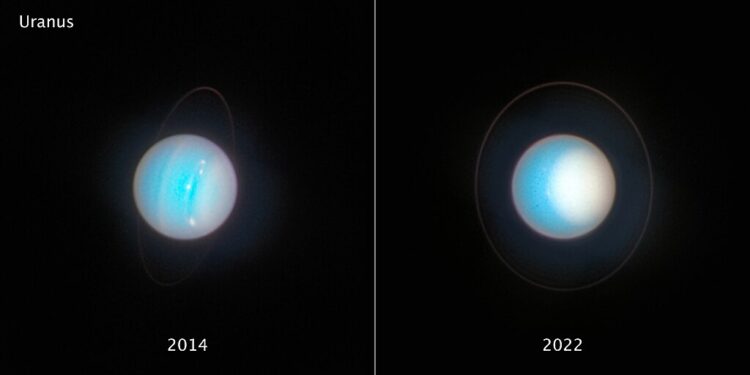Uranus, the seventh planet from the Sun, is one of the solar system’s most mysterious giants. Its unique tilt—almost 98 degrees off vertical—makes it stand out, with the planet effectively orbiting the Sun on its side. But why does Uranus have such an unusual orientation? Scientists believe that a massive collision with an Earth-sized object during the planet’s formation may have knocked it over, and new research sheds light on this cosmic event and its consequences.
The leading hypothesis is that Uranus’ extreme tilt is the result of a cataclysmic impact. During the early days of the solar system, around 4.5 billion years ago, Uranus likely formed closer to the Sun before migrating to its current position. However, at some point during this process, it is believed that a massive object—roughly twice the size of Earth—collided with Uranus, knocking it sideways.
Researchers have used simulations to model this impact, and their findings strongly support the collision theory. Dr. Jacob Kegerreis from Durham University led a study in 2018 that confirmed the most likely outcome of such a collision was Uranus being tipped on its side. This dramatic event not only explains the planet’s strange tilt but also helps scientists understand other unusual features of Uranus, such as its moons and rings, which may have been influenced by the aftermath of the impact.
Uranus’ tilt leads to some of the most extreme seasonal variations in the solar system. With its equator almost perpendicular to its orbit, one pole of Uranus faces the Sun for nearly 21 years while the other remains in complete darkness. After this long polar summer and winter, the situation reverses as the planet continues its 84-year orbit around the Sun.
This extreme axial tilt has profound effects on the planet’s weather and atmospheric conditions. Uranus experiences rapid changes in its cloud formations and wind patterns as different regions receive varying amounts of sunlight over the course of its orbit. These unique dynamics make Uranus an intriguing object of study for planetary scientists, offering insights into how axial tilt can influence a planet’s climate and atmospheric behavior.
Simulations have been key to understanding how Uranus’ tilt was created and how it continues to shape the planet today. Researchers have used computer models to replicate the collision and its long-term effects on Uranus’ orbit, moons, and rings.
One question that remains is why Neptune, Uranus’ sister planet, did not experience a similar collision. Both ice giants formed under similar conditions, yet Neptune does not have the same extreme tilt. This leads some scientists to consider alternative explanations, such as the possibility that Uranus once had a large moon that gradually shifted its axis over time. However, for now, the colossal impact theory remains the most widely accepted explanation.
While simulations have provided valuable insights, further exploration is needed to fully understand Uranus’ history and the forces that shaped it. A probe dedicated to studying Uranus and its moons could provide critical data to confirm the collision theory and reveal more about the planet’s internal structure, atmosphere, and magnetic field. Such a mission would not only deepen our understanding of Uranus but also offer broader insights into the formation of other ice giants and exoplanets with similar characteristics.
NASA has identified Uranus as a top priority for exploration in its upcoming missions, and scientists hope that a dedicated probe could be launched in the coming decades. By closely studying Uranus, we may uncover more about the events that shaped the early solar system and gain a better understanding of how planets evolve in different environments.



















